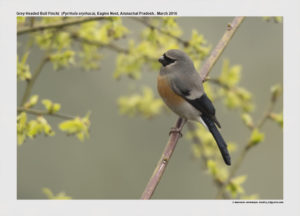Grey-headed-Bullfinch

Grey-headed Bullfinch Pyrrhula erythaca
Etymology:
- Pyrrhula : Greek word purrhoulas worm-eating bird ; Pyrrha– Flame coloured
- Erythaca: Greek word erithakos – usually associated with bird with red breast
Vernacular Name: Lepcha: Kobyu
Distribution in India: Resident of Eastern Himalayas in India.
Description: Size of 16-17 cm. It is a Medium-large bullfinch with curved bill and slightly notched tail. The male of nominate race has lower forehead and lores to behind eye and across cheek to chin black, narrowly bordered with pale buff or whitish-buff; forecrown to nape, side of neck and rest of face to lower throat and upperparts pale grey, upperparts slightly darker than crown, band of black across lower back, rump white, uppertail-coverts glossy black; tail black, glossed bluish; upperwing black, median coverts broadly tipped pale grey, greaters edged purplish-black at base and broadly tipped pale grey, outer 2–3 more narrowly tipped white, flight-feathers black, secondaries and tertials glossed bluish-black or tinged purplish; breast to upper flanks deep orange-rufous, tinged yellowish at side, pale grey on rear flanks and belly; vent to undertail-coverts white; iris black; bill dark grey or blackish; legs pink to grey or grey-brown. Female has forehead to nape like male, but duller or tinged brownish; rear ear-coverts and side of neck pale greyish-buff, upperparts dull grey-brown, lower back black or purplish-black, rump white; uppertail-coverts, tail and wing as on male, but wing-coverts tipped duller grey or greyish-buff; cheek and ear-coverts dull grey-brown or buffish-brown, underparts warm buff-brown, vent to undertail-coverts white; bare parts much as for male.
Habitat: It is found in Lower montane and submontane conifer forest and mixed forest at heights of 2000-3800 m. In non-breeding season at lower levels of 2000–3200 m.
Food Habits: It eats plant and tree seeds, buds, catkins, shoots, leaves, fruit and berries, also nectar; also insects and larvae and other arthropods. It makes daily descent of up to 2 km in early morning to feeding areas, returning to higher areas later in day. It forages low down in bushes and hillside scrub and vegetation, or on the ground. Usually found in pairs during breeding season and also in small family groups.
Breeding Habits: They breed in June-July in India. The nest is built by female. The nest is a loosely constructed cup of twigs, lined with fine rootlets, placed above ground on horizontal branch of conifer. It lays a clutch of 3 eggs and incubation is done by female.